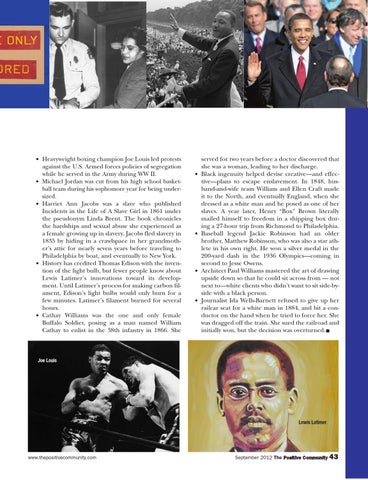PROFILES
• Heavyweight boxing champion Joe Louis led protests against the U.S. Armed forces policies of segregation while he served in the Army during WW II. • Michael Jordan was cut from his high school basketball team during his sophomore year for being undersized. • Harriet Ann Jacobs was a slave who published Incidents in the Life of A Slave Girl in 1861 under the pseudonym Linda Brent. The book chronicles the hardships and sexual abuse she experienced as a female growing up in slavery. Jacobs fled slavery in 1835 by hiding in a crawlspace in her grandmother’s attic for nearly seven years before traveling to Philadelphia by boat, and eventually to New York. • History has credited Thomas Edison with the invention of the light bulb, but fewer people know about Lewis Latimer’s innovations toward its development. Until Latimer’s process for making carbon filament, Edison’s light bulbs would only burn for a few minutes. Latimer’s filament burned for several hours. • Cathay Williams was the one and only female Buffalo Soldier, posing as a man named William Cathay to enlist in the 38th infantry in 1866. She
•
•
•
•
served for two years before a doctor discovered that she was a woman, leading to her discharge. Black ingenuity helped devise creative—and effective—plans to escape enslavement. In 1848, husband-and-wife team William and Ellen Craft made it to the North, and eventually England, when she dressed as a white man and he posed as one of her slaves. A year later, Henry “Box” Brown literally mailed himself to freedom in a shipping box during a 27-hour trip from Richmond to Philadelphia. Baseball legend Jackie Robinson had an older brother, Matthew Robinson, who was also a star athlete in his own right. He won a silver medal in the 200-yard dash in the 1936 Olympics—coming in second to Jesse Owens. Architect Paul Williams mastered the art of drawing upside down so that he could sit across from — not next to—white clients who didn’t want to sit side-byside with a black person. Journalist Ida Wells-Barnett refused to give up her railcar seat for a white man in 1884, and bit a conductor on the hand when he tried to force her. She was dragged off the train. She sued the railroad and initially won, but the decision was overturned.
Joe Louis
Lewis Latimer
www.thepositivecommunity.com
September 2012 The Positive Community
43
